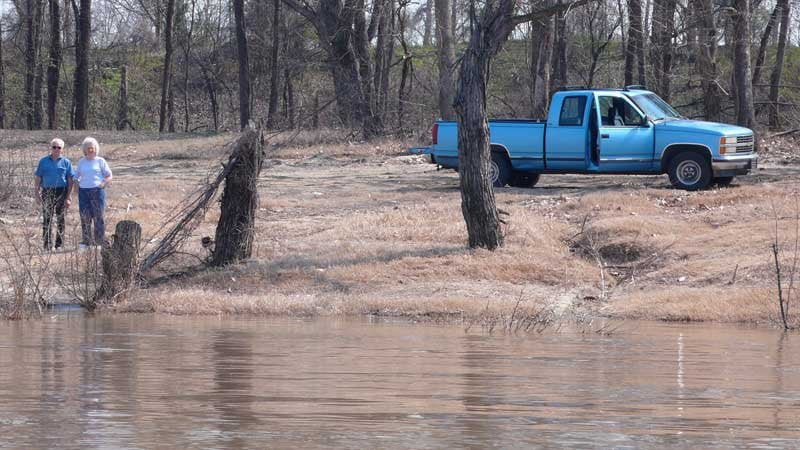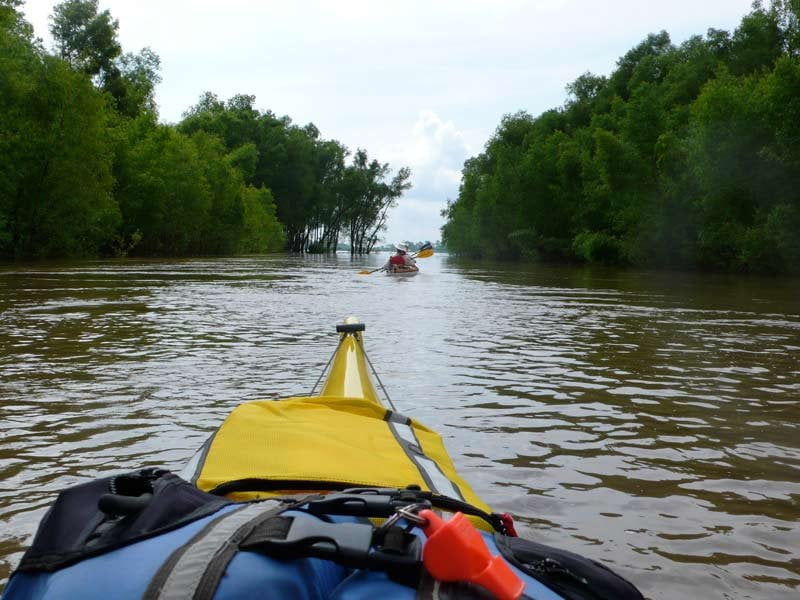The Lower Mississippi River Water Trail
Even within the shadow of its blues-tourism drenched neighbor, Clarksdale, there are many reasons to walk over the levee for a quick visit. Friars Point was the Childhood home of Conway Twitty and Aretha Franklin’s Daddy, The Rev. C.L. Franklin. The postal packet the Kate Adams made regular landings here enroute Arkansas City and Memphis. Muddy Waters reported seeing Robert Johnson perform in front of Hirsberg Grocery. The bench that Robert Johnson performed on still sits in front of the grocery, now painted fire-engine red. Friars Point was the original ferry landing for access to Helena. All blues musicians in the area passed through to get to Helena’s influential King Biscuit Time radio program. If you stop, be sure to visit the North Delta Museum and Icehouse Antiques. Paddlers can find a limited selection of groceries at a couple of markets, one of which has noteworthy take-out lunches quick fried on a gigantic iron wok. Friars Point also has a liquor store and a post office.
LBD 652.5 Friars Point Landing (unimproved)
Several hundred yards below the McAlister Grain/Mississippi Limestone complex (you will see a line of shiny stainless steel grain elevators and piles of gravel and anchored tows) you can find a serviceable landing with access to Friars Point. Unimproved location. Primitive landing on muddy banks topped with sandy/muddy flats. Not recommended camping. Hide your vessel above or below and carry all valuables if you leave landing to visit Friars Point. At low water steep muddy banks with gooey muddy bottoms. At high water landing becomes submerged around HG 35, but paddlers can simply pull in wherever a good spot is found along the levee.
652-650 LBD FRIARS POINT island
[CLICK HERE: Map of Friar’s Point Island]
Immediately downstream of the primitive Friars Point Landing mile 652.5 is a narrow opening tight against the Mississippi shoreline that at any water levels above 20 HG offers glimpses into the wild world of the ancient Mississippi, where steep muddy banks and vine-draped trees prevail. Follow the river downstream along the shoreline over several short old-style wood pier dikes. Note: if you can see the dikes protruding above the river’s surface you won’t be able to paddle this back channel, angle outwards along the Friars Point Bar and re-enter the main channel below. If you can’t see the dikes the back channel should be open. Go for it: it’s well-worth the extra effort. Below the third such short dike is a big eddy below which you will see water sluicing in to the left of a willow-topped island. Follow it in and paddle as quietly as you can if you want to see any wildlife. The beaver love this back channel, typically positioning themselves on little muddy perches or shelves formed by the muddy banks. Best time to see beaver: first thing in the morning or late in day. On cold winter days they might be caught sunbathing on a pile of driftwood, and in warmer days they might all be hiding within their dens. Oftentimes they leap out of their muddy burrows as you pass. You might notice a blur of fur and see the splash. Unless you’re watching carefully and listening you won’t see anything at all. [CLICK HERE: for how to paddle quietly — or two ways to paddle]. There are two places where the back channel crosses dikes, now submerged, you might see some boiling action. Otherwise this channel is an enjoyable meandering waterway that might put you in mind of some remote tributary on the Amazon or the Congo. Pileated woodpeckers are common, and during the annual spring migration, the many brightly colored songbirds fill the forests with their crystalline melodies. This is a good place to relax a moment from the rigors of the main channel, you could even take a nap it is normally so peaceful & gentle. After a mile or more, the southwesterly back channel curves ever more westward along lines of mature willow trees, and then a striking wall of tall & stately willows are seen with the glorious light of the open channel behind, the main river is a mile wide here so it feels like you’re headed towards a gate leading into the open ocean or something. Unless it’s blocked with driftwood & debris, paddle on through and re-enter the big river to sail downstream towards Miller Point. If the gateway is blocked with logs, you’ll find an opening on one side or the other. I’ve never seen it completely occluded. Worse case scenario, pull up to one side and push your vessel or portage over.
[Click Here: Beavers]
Beavers on the Lower Mississippi River
The beavers of the Lower Miss usually don’t bother building beaver dams and beaver lodges. Why not? It must be a specialized adaptation unique to the floodplain of the big river. They don’t build lodges because the next high water will probably wash them away. With a river that annually fluctuates 50 vertical feet you can imagine the difficulties of keeping your home made of sticks in one place. Instead they dig holes on steep muddy banks, oftentimes underneath a root ball or fallen tree, or some other natural obstruction. They don’t build dams because they don’t have to. There is always enough deep water for the beaver to get to the next stand of willow for the overnight feast. As you paddle along look closely and you will be astounded length and depth of the floodplain willow forests, sometimes miles and miles of willows, walls of willows so long and so deep you feel like you are a visitor in a fragrant green canyon of lush willows. Everything about the willow is beautiful, and in all seasons it fills the air with refreshing aromas. Look closer and you will see the lines of sharpened willow stakes where once stood lines of trees. The beavers cut the willow tree down with their sharp two dagger-like teeth, and then drag then willow trunk to the water’s edge. Water is their safety. If any predator approaches they can make a quick exit by silently sliding into the river. I’ve never seen a beaver eating except at the water’s edge. Here they hold the willow with their two paws, rotating it as they rip off mouthfuls of cambium, smacking loudly as they do so, and deftly clip away small branches and any unwanted parts. Beavers are nocturnal, so most likely you will hear them chewing their sticks after dark, it sounds like someone chewing loudly on an ear of corn-on-the-cob. Or you might be startled to hear a loud splash! as you lay in your sleeping bag. Don’t be alarmed (like I was the first time I heard this sound). It’s not someone terrorizing your campsite. The beaver is making himself known, establishing territory, and hoping you will leave so he can enjoy his personal beach minus your uninvited company! Usually they settle down and assimilate themselves to your presence, or move elsewhere. Periodically, however, they maintain an all night show of loud slaps in your vicinity. Beaver are known to sample other woods, they might try a bite of your canoe if it was made of untreated & unprotected wood. If no willow is to be had, cottonwood is second best.





Leave A Comment
You must be logged in to post a comment.